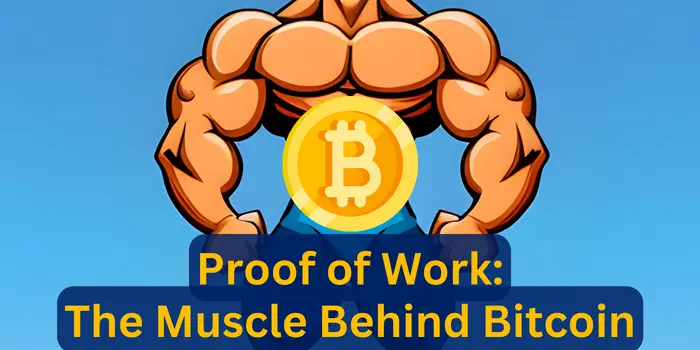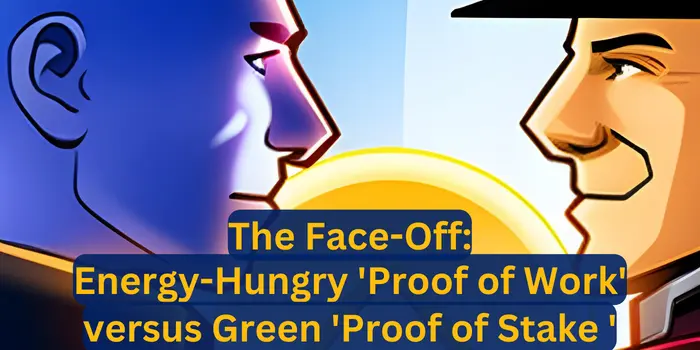
Diving into the crypto world, we come across two significant buzzwords: validation and verification.
Let's embark on a journey to untangle these concepts, shedding light on their critical roles in making digital currencies secure and transparent through the magic of blockchain technology.
Blockchain technology is like a transparent ledger where everyone can view the transaction details. Think of Proof-of-Stake (PoS) validators and Proof-of-Work (PoW) miners as digital security guards, the former putting down a deposit (staking) and the latter solving a tough puzzle (mining) to confirm each transaction is legit. While the puzzle-solving miners create a secure and decentralized environment, the deposit-placing validators offer a more energy-efficient and speedy process, hinting at a greener and faster future for cryptocurrencies.
Imagine a stack of transparent boxes in the middle of a crowded room. Each box has a special message inside. Once a message is put in a box and stacked, it can't be changed or removed - everyone can see it and confirm it's real. That's what blockchain technology is like.
Blockchain became popular because of Bitcoin, but it's more than just digital money. It's a new, secure way to share information, and it's changing how we do business.
Think about blockchain as a set of building blocks. Each block is a piece of data, like a record of someone buying something. When a new block is ready, it's securely linked to the last block, creating a "chain." This keeps the data safe and stops anyone from messing with it.
What's cool about blockchain is that it cuts out the middleman. Normally, when you send money, there's a bank in the middle, making sure you have the cash to send and that the recipient gets it. But with blockchain, everyone can see that you made the transaction, so you don't need a bank to vouch for you.
Here's how it works. Blockchain uses a "distributed ledger." It's like a shared notebook where all the transactions are recorded. Everyone on the blockchain network has a copy of this notebook. So, if anyone tries to change something, everyone will know.
Another part of blockchain is "smart contracts." These are rules that automatically do something when certain conditions are met. For example, when money gets into your account, a smart contract could automatically pay your bills.
People trust blockchain because it's transparent and secure. Everyone can see what's happening, and no one can change anything once it's recorded. It also makes things more efficient because it cuts out extra steps and waiting times in transactions.
There are different kinds of blockchains. Some are open to everyone (like Bitcoin), some are controlled by a single group, and some need special permission to join. Some types are even managed by a group of organizations.
Different "blueprints" or protocols exist for building blockchains, including Hyperledger Fabric, Ethereum, Corda, and Quorum. Each one has special features that make it better for certain tasks.
Like all tech stuff, blockchain keeps changing and getting better. It began with Bitcoin, then smart contracts were added, and now, people are finding all sorts of ways to use it. It's a big deal, and it's just getting started!

PoS validators make sure every play (or transaction) follows the rules.
When you hear about mining Bitcoin, that's a different system called Proof-of-Work. Crypto validating happens in a different type of network called Proof-of-Stake. In these networks, validators put up some of their own digital coins as a kind of security deposit. It's like they're saying, "I promise to play by the rules, and here's some of my own money to prove I'm serious."
Crypto validators have a few key jobs. First, they check every transaction to make sure it follows the network's rules. It's like a referee checking every move to make sure no one's cheating. Second, they help everyone agree on what the history of transactions looks like. And lastly, they keep the network safe by blocking any fake transactions.
So, how does someone become a validator? They need to pick a network, set up the right software and hardware, and run a node, which is like a checkpoint on the network. They use special software to talk with other nodes, keep a record of transactions, check transactions, and add new blocks of transactions to the chain. As a reward, validators get paid in digital coins.
Being a validator isn't all sunshine and rainbows, though. If a validator doesn't do their job correctly, they can be penalized, or "slashed," which means losing some of the coins they put up as a security deposit. It's like a referee being fined for making a bad call in a game. Validators also tie up their coins for a certain amount of time, so they can't sell them if the market changes. And there are costs to get started, like buying the right hardware and paying for electricity and internet. But, for many, the rewards outweigh the risks.

Let's dive into Proof of Work (PoW), a vital part of how Bitcoin and other cryptocurrencies work. Think of it like a tough security guard making sure everything's in order.
PoW is like a game with a prize. In this game, players, called miners, race to solve a super-hard math problem. The first one to solve it gets to add a bundle of transactions, known as a block, to the chain of all past transactions (the blockchain). The winner also gets rewarded with some shiny new Bitcoins or other cryptocurrencies.
Each block has a unique ID code, a bit like a fingerprint. The tricky part for miners is to find this code. It has to be a specific kind of number, and they can only find it by making lots and lots of guesses. They use powerful computers to do this as fast as they can.
Bitcoin uses PoW to keep the system secure and democratic. It stops anyone from trying to cheat by spending the same Bitcoin twice or changing past transactions. It's like having a group of super-fast accountants checking everything is above board.
PoW is a pretty solid system, but it does have some downsides. For one, it uses a lot of electricity because those powerful computers need a lot of energy to run. This has led to some people worrying about the impact on the environment.
Also, while it's meant to be democratic, there's been some concern that too much power is getting concentrated in a few big mining operations. These are places where people have a lot of computers all working together to solve the problem faster.
In a nutshell, PoW is the muscle that keeps Bitcoin and other cryptocurrencies running smoothly. It's a security guard, a referee, and a rewards system, all in one. But like anything, it's not perfect and comes with its own set of challenges.
Imagine if you could earn money by showing how much you own, instead of how hard you can work. That's the principle behind Proof of Stake (PoS), a method that some digital coins use to keep track of transactions.
Unlike the Proof of Work method used by Bitcoin, where people earn coins by solving complex math problems, PoS works on trust. Here, participants, known as validators, show they are trustworthy by locking away some of their own digital coins. This lock-up is called a 'stake', and it's like a deposit that guarantees they'll play by the rules.
Who gets to add the next block of transactions to the blockchain? That's where the stake comes in. The more a validator stakes, the more likely they are to be picked. Once they've added a block and everyone agrees it's correct, they get rewarded with more coins.
Why do people like PoS? It uses less energy than Proof of Work because there are no complex problems to solve. This means it's more environment-friendly. Also, because anyone can stake coins, more people can take part. A platform you probably heard of, Ethereum recently switched to PoS, which helped it handle more transactions and use less energy.
What happens if a validator tries to cheat or makes a mistake? Well then, they lose some, if not all, of the crypto that they staked. It's like a casino confiscating a cheater's chips. This threat keeps the validators honest and the system secure.
One concern about PoS is what's called a 51% attack, where someone could take control if they own most of the staked coins. But most people think this is unlikely because it would cost a boatload to buy that many coins.

Let's compare two major methods that cryptocurrencies use to keep everything honest: Proof of Work (PoW) and Proof of Stake (PoS). Even though they do the same job, they work quite differently.
PoW is like a high-stakes math race. 'Miners' compete to solve tricky puzzles using a lot of computer power. The first one to solve the puzzle gets to add the next batch of transactions to the blockchain, and in return, earns some new coins.
PoS, on the other hand, is more like a lottery. Participants called 'validators' lock up some of their coins as a kind of security deposit. The more they lock up, the better their chances of being chosen to add the next batch of transactions and earn the reward.
Both methods want to keep things honest. If a miner in PoW tries to cheat, they just waste a lot of time and electricity because their block won't get accepted. In PoS, a validator who tries to cheat could lose all the coins they've staked.
PoW has been criticized for using a lot of energy. It's also slow, and the mining power tends to get concentrated in the hands of a few big players. PoS is much more energy-efficient and can handle transactions a lot quicker. Plus, since anyone can be a validator if they stake coins, it's more decentralized.
One major coin, Ethereum, has recently switched from PoW to PoS because it's faster, more secure, and much greener. This is a big deal because it could encourage more people to use cryptocurrencies.
When it comes to security, PoW relies on miners playing by the rules. But if a miner gets control of 51% of the total mining power, they could cheat the system. PoS has a natural defense against this kind of attack because an attacker would have to buy a massive amount of coins, and if they tried to cheat, they'd lose them all.
Verification in software testing is like a quality control check during the building of software. It's about making sure the software being built is up to the standards and matches the initial plans. This process includes reviewing the code, inspecting designs, and ensuring it all aligns with what the customers and business need. In short, it's about confirming that the software's nuts and bolts are working exactly as they're supposed to.
Validation in software testing is akin to a final test drive of a car before it hits the market. It's about ensuring the software isn't just built according to plan but also performs well and meets the users' needs in different situations. This involves different types of testing, such as user acceptance testing and system testing, performed toward the end of the development. Simply put, it's like giving the software a final examination to make sure it's ready to serve its purpose effectively.
Think of verification and validation in software testing like baking a cake. Verification is like checking if you have all the correct ingredients according to the recipe before you start baking, ensuring that everything is in line with the plan. On the other hand, validation is like tasting the cake after it's baked to make sure it's delicious and meets everyone's expectations. In simpler terms, verification happens first, making sure you're following the directions and making the cake right, while validation follows, ensuring you've actually made the right cake.
When dealing with digital money like Bitcoin or Ethereum, it's critical to ensure everything's fair and secure - that's where Proof of Stake (PoS) and Proof of Work (PoW) come in. In PoS, validators (think of them as digital police) put up some of their own digital cash as a pledge to play nice - if they cheat, they lose that money. They help maintain the blockchain's truth and are excellent at stopping any dishonest actions. On the other hand, in PoW, miners (imagine them as digital gold diggers) solve tough puzzles with their computers. The first one to crack the puzzle gets a digital coin prize. Both PoS and PoW aim to keep things honest, but they do so differently, each with its own benefits and drawbacks. PoS is like a sleek electric car - energy-efficient, fast, and with built-in security (like losing your stake if you cheat), while PoW is more of an old diesel truck - trusted and reliable, but can be slow and guzzles fuel. By understanding these differences, we can see how digital currencies ensure everything remains transparent and trustworthy.